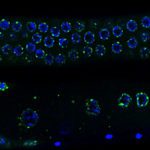Lien vers Pubmed [PMID] – 28091568
Lien DOI – 10.1038/srep40618
Sci Rep 2017 Jan; 7(): 40618
Crosses between close species can lead to genomic disorders, often considered to be the cause of hybrid incompatibility, one of the initial steps in the speciation process. How these incompatibilities are established and what are their causes remain unclear. To understand the initiation of hybrid incompatibility, we performed reciprocal crosses between two species of Drosophila (D. mojavensis and D. arizonae) that diverged less than 1 Mya. We performed a genome-wide transcriptomic analysis on ovaries from parental lines and on hybrids from reciprocal crosses. Using an innovative procedure of co-assembling transcriptomes, we show that parental lines differ in the expression of their genes and transposable elements. Reciprocal hybrids presented specific gene categories and few transposable element families misexpressed relative to the parental lines. Because TEs are mainly silenced by piwi-interacting RNAs (piRNAs), we hypothesize that in hybrids the deregulation of specific TE families is due to the absence of such small RNAs. Small RNA sequencing confirmed our hypothesis and we therefore propose that TEs can indeed be major players of genome differentiation and be implicated in the first steps of genomic incompatibilities through small RNA regulation.


